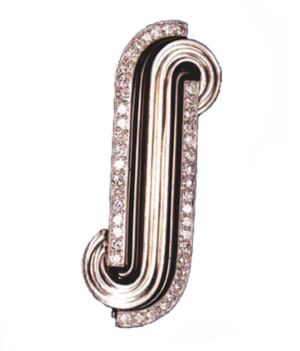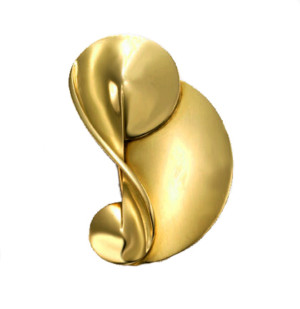(1891 – 1968)
Raymond Templier, like many of his contemporaries in jewelry, was born to a family with a long tradition as jewelers. His grandfather, Charles, founded the firm of Templier in Paris in 1849. His son Paul, father of Raymond, continued the tradition. Raymond entered the business in 1919.
From 1909 until 1912, Raymond studied at the Ecole Superior des Arts Decoratives in Paris. After completing his studies, he joined the family jewelry business. Raymond, however, was not interested in making the kind of traditional jewelry that the House of Templier had been producing. He had already been doing some innovative designing – his earlier designs were not yet Cubist, but quickly became increasingly so. He was interested in the images that were coming out of Cubism-he wanted to translate Cubist ideas into jewelry. In 1911, he exhibited at several important Salons, and also became a member of the Conseil Superior des Arts Decoratifs . He also participated in the 1925 and 1937 Paris Exphibitions.
Templier was an important figure in the Art Deco movement. He was one of the founders of the UAM – UNION DES ARTISTES MODERNES, along with such other important figures as Pierre Chareau and Jean Puiforecat.
Templier personally designed every piece of jewelry that bears his signature. His drawings are not only quite beautiful, but they also show his fascination with certain forms that recur in many of his designs.
He was fascinated by the juxtaposition of opposing arcs and semi-circles, and various inverted triangles. He used these motifs in many innovative ways. His forms are perfect expressions of the interplay of light and volume. His explorations of these themes produced some of the most powerful and sophisticated jewelry of the period. In 1919, he began a collaboration with designer Marcel Pecheron. The jewels were made by Théodore Lambert.
Like most of the “artist-jewelers” of the time, he was not especially interested in precious materials. He used silver and white gold interchangeably, with lacquer or enamel, usually black but sometimes green. He liked diamonds for their effect, and used them for their sparkle and lack of color – to bring light to a jewel, much as an architect used windows. He did some jewelry that is all in diamonds, but his really great work used them more for accent, and used color, usually a deep green, or perhaps some coral, very sparingly.
His best pieces, combining white gold, diamonds and black lacquer or only are, at their best, stunning in their power and simplicity. One can imaging one of Legere’s women, with her “machined” hair, wearing Templier’s jewels.
Going into the 1930’s, his lines become more curved and sensual, and he was working now in polished yellow gold – these were both trends of the late Twenties – Thirties. He remained obsessed with the motif of a circle with a curved and a straight arm that meet. This creates a very dynamic form. In 1935, he took over his father’s business.
Templier continued to do some jewelry after the war, but the inspiration was gone – he had said everything that he had to say about Art Deco, and failed to become successfully engaged in the design movements that followed.
Showing all 2 results



